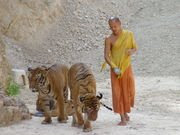
The
Burma Railway, also known also as the
Death Railway, the
Thailand-Burma Railway and similar names, is a 415 km (258 mile) railway between Bangkok, Thailand and Rangoon, Burma (now Myanmar), built by the Empire of Japan during World War II, to support its forces in the
Burma campaign.
Forced labour was used in its construction. About 60,000 Asian labourers and 100,000 Allied
prisoners of war (POWs) worked on the railway. Of these, around 9,000 Asian labourers and 16,000 Allied POWs died as a direct result of the project. The dead POWs included 6,318 and some British personnel, 2,815 Australians, 2,490 Dutch, about 356 AmericansCanadians.
A railway route between Thailand and Burma had been surveyed at the beginning of the 20th century, by the British government of Burma, but the proposed course of the line — through hilly jungle terrain divided by many rivers — was considered too difficult to complete.
In 1942, Japanese forces invaded Burma from Thailand and conquered it from Britain. To maintain their forces in Burma, the Japanese had to bring supplies and troops to Burma by sea, through the Strait of Malacca and the Andaman Sea. This route was vulnerable to attack by Allied submarines, and a different means of transport was needed. The obvious alternative was a railway. The Japanese started the project in June 1942.
They intended to connect Ban Pong with Thanbyuzayat, through the Three Pagodas Pass. Construction started a t the Thai end on 22 June 1942 and in Burma at roughly the same time. Most of the construction materials for the line, including tracks and sleepers, were brought from dismantled branches of the Federated States of Malaya Railways network and from the Netherlands East Indies.
t the Thai end on 22 June 1942 and in Burma at roughly the same time. Most of the construction materials for the line, including tracks and sleepers, were brought from dismantled branches of the Federated States of Malaya Railways network and from the Netherlands East Indies.
On 17 October 1943, the two sections of the line met about 18 km south of the Three Pagodas Pass at Konkuita (Kaeng Khoi Tha), Sangkhla Buri district, Kanchanaburi Province). Most of the POWs were then transferred to Japan. Those left to maintain the line still suffered from the appalling living conditions as well as Allied air raids.
The most famous portion of the railway is probably Bridge 277 over the Khwae Yai River (Thai แควใหญ่, English "big tributary"). (The river was originally known as the Mae Klong and was renamed Khwae Yai in 1960.) It was immortalized by Pierre Boulle in his book and the film based on it: The Bridge on the River Kwai. However, there are many who say that the movie is utterly unrealistic and does not show what the conditions and treatment of prisoners was really like.[1] The first wooden bridge over the Khwae Noi (Thai แควน้อย, English "small tributary") was finished in February 1943, followed by a concrete and steel bridge in June 1943. The Allies made several attempts to destroy the bridges, but succeeded only in damaging them in their first attempts. On 2 April 1945, AZON bomber crews from the U.S. 458th Heavy Bombardment Group destroyed Bridge 277. After the war, two squarish central sections were made in Japan to repair the bridge, and were donated to Thailand.
Post-war
After the war the railway was in too poor a state to be used for the civil Thai railway system, and needed heavy reconstruction. On 24 June 1949, the first part from Kanchanaburi to Nong Pladuk (Thai หนองปลาดุก) was finished; on 1 April 1952, the next section up to Wang Pho (Wangpo); and finally on 1 July 1958, up to Nam Tok (Thai น้ำตก, English "waterfalls".) The portion of the railway still in use measures about 130 km. Beyond Nam Tok, the line has been abandoned. Steel rails have been removed for reuse in expanding the Bangsue railway yard, reinforcing the BKK-Banphachi double track, rehabilitating the track from Thung Song to Trang, and constructing both the Nong Pladuk-Suphanburi and Ban Thung Pho-Khirirat Nikhom branch lines. Parts of it have been converted into a walking trail.
Since the 1990s there have been plans to rebuild the complete railway, but these plans have not yet come to fruition.
























